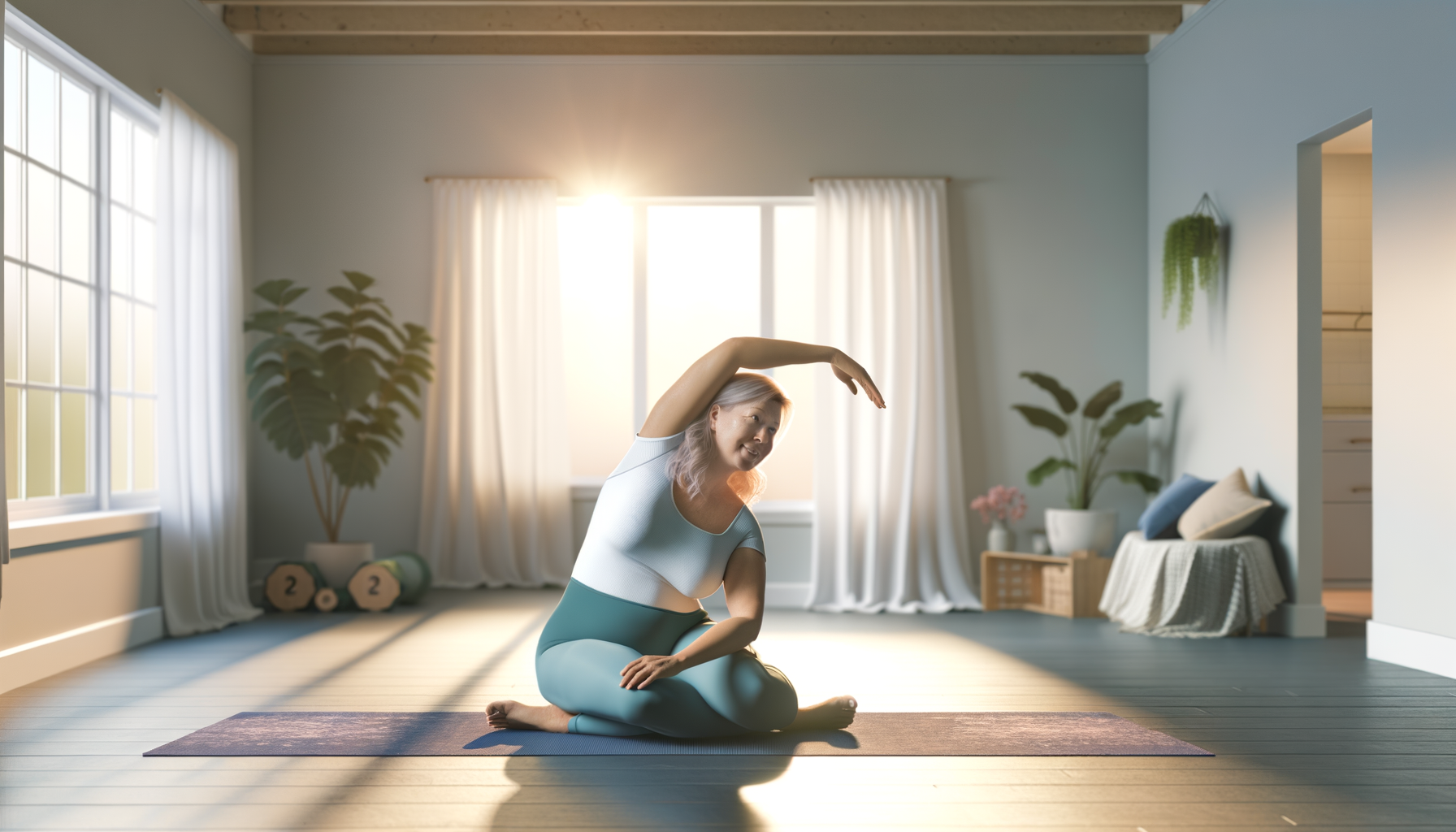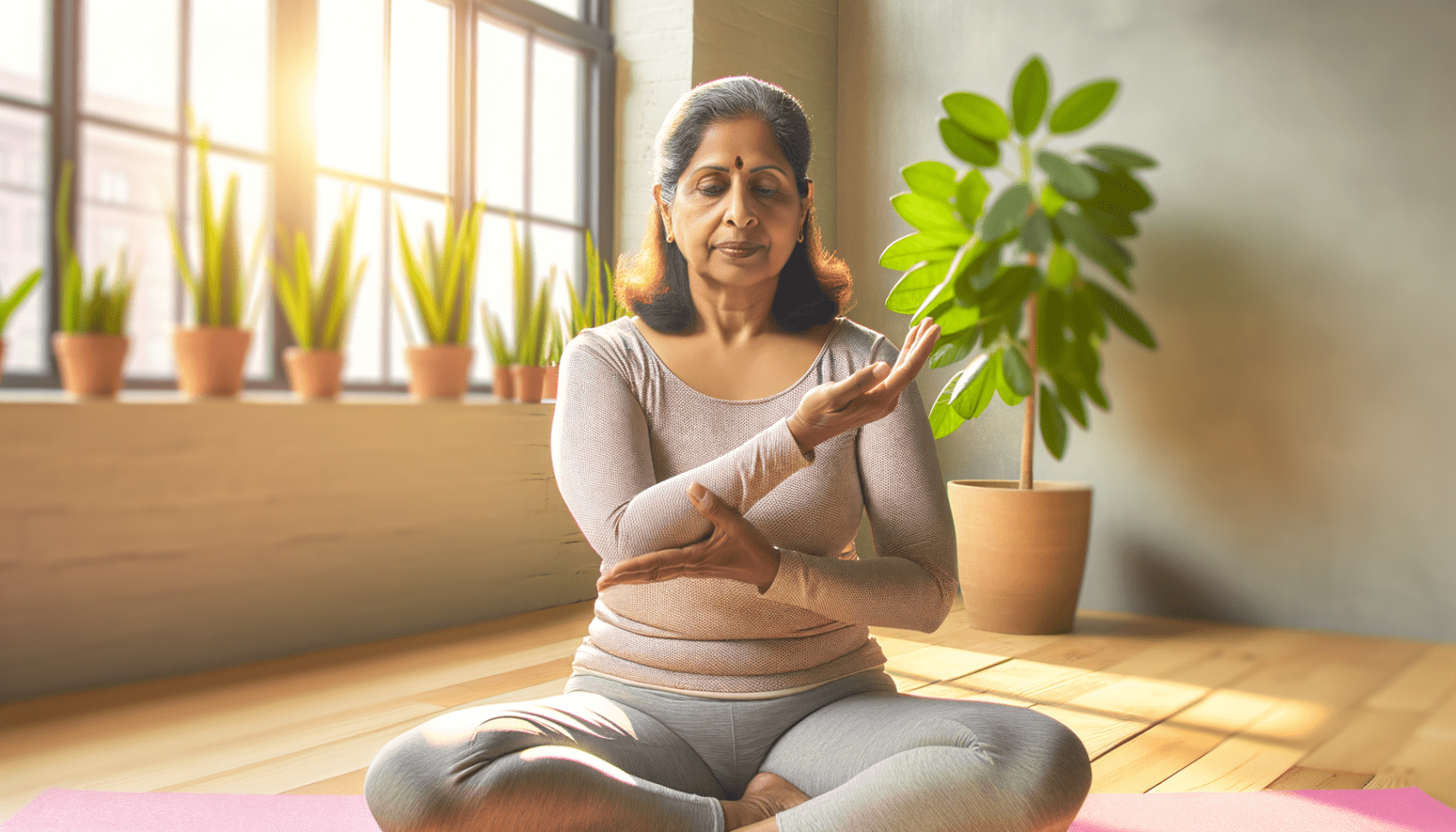Menopause and Stretching
Menopause marks a significant transition in a woman’s life, typically occurring in the late 40s to early 50s. It is characterized by the cessation of menstrual periods and a decline in the production of hormones such as estrogen and progesterone. This hormonal shift can lead to a variety of symptoms, including hot flashes, night sweats, mood swings, sleep disturbances, and vaginal dryness. Additionally, women may experience increased joint stiffness, muscle tension, and a decrease in bone density, which can contribute to discomfort and reduced mobility.
The Role of Stretching in Alleviating Symptoms
Stretching plays a crucial role in managing menopause symptoms. Gentle stretches can help alleviate muscle tension and joint stiffness, promoting relaxation and enhancing overall flexibility. By incorporating stretching into their daily routine, menopausal women can maintain a greater range of motion, reduce the risk of injury, and improve their quality of life. Stretching can also be a calming activity that helps to reduce stress and anxiety, which are common during this phase of life.
The Impact of Exercise Intensity on Menopause
The intensity of exercise during menopause can have varying effects on symptoms. While moderate aerobic activity is beneficial for cardiovascular health and weight management, high-impact exercises may not be suitable for all women, especially those with osteoporosis or joint pain. Conversely, low-intensity exercises, such as yoga and Pilates, can be particularly beneficial as they combine stretching with mindful breathing and low-impact strength training, offering a holistic approach to managing menopause symptoms.
Overview of Stretching Benefits for Menopausal Women
- Enhanced Flexibility: Regular stretching can help counteract the natural loss of flexibility that occurs with aging and hormonal changes, aiding in daily activities and exercise.
- Improved Circulation: Stretching encourages blood flow to the muscles, which can help reduce hot flashes and promote healing and tissue health.
- Stress Relief: Stretching routines often incorporate deep breathing, which can help lower cortisol levels and alleviate feelings of anxiety and irritability.
- Better Sleep: Gentle stretching before bedtime can relax the body and mind, leading to improved sleep quality, which is often disrupted during menopause.
- Reduced Muscle and Joint Pain: By maintaining muscle elasticity and joint mobility, stretching can help relieve the aches and pains associated with menopause.
In conclusion, gentle stretching offers a range of benefits that can help menopausal women navigate the physical and emotional challenges of this life stage. By integrating a regular stretching routine, women can enhance their well-being and continue to lead active, fulfilling lives.
Managing Hot Flashes Through Stretching
Prevalence and Challenges of Hot Flashes
Hot flashes are one of the most prevalent symptoms of menopause, affecting approximately 80% of women. This sudden feeling of warmth can spread throughout the body and is often accompanied by sweating and a reddened face. The unpredictability and discomfort of hot flashes pose significant challenges to daily life, disrupting sleep and contributing to stress and anxiety.
Restorative Stretches for Cooling the Body
Restorative stretches can play a crucial role in cooling the body and managing hot flashes. These gentle movements help to relax the nervous system and promote a sense of calm. By focusing on slow, deliberate stretching, women can create a cooling effect on the body, which may help to reduce the frequency and intensity of hot flashes.
Recommended Low-Intensity Exercises
Low-intensity exercises are highly recommended for women experiencing hot flashes. Activities such as walking, swimming, and gentle yoga can provide the benefits of exercise without exacerbating symptoms. It’s important to engage in activities that do not trigger the sweat glands excessively, as this can lead to increased body heat and potentially trigger more hot flashes.
Specific Stretches to Reduce Hot Flashes
- Tricep Extensions: This stretch helps to strengthen and tone the upper arms, which can lose muscle mass with age. It also works into the shoulders, offering relief for those who spend long hours at a desk.
- Forward Folds: Placing the head below the heart sends oxygenated blood to the brain, signaling relaxation. This can be particularly beneficial for calming the mind and reducing stress that may trigger hot flashes.
- Reclining Bound Angle Pose (Supta Baddha Konasana): This pose allows for complete relaxation of the body and can be held for several minutes to encourage deep breathing and stress relief.
- Downward-Facing Dog (Adho Mukha Svanasana): This pose calms the brain and can help relieve stress, which is often a precursor to hot flashes.
By incorporating these specific stretches into a daily routine, menopausal women can create a holistic approach to managing hot flashes and improving overall well-being.
Combating Anxiety and Irritability
Hormonal Fluctuations and Anxiety
Menopause is often accompanied by a rollercoaster of hormonal changes, particularly in estrogen levels. Estrogen is known to play a crucial role in managing brain chemicals that influence mood and emotion. As these levels decline, many women experience heightened symptoms of anxiety and irritability. This can manifest as a persistent sense of nervousness, unease, or even panic attacks, significantly impacting daily life.
Forward Folds for Mental Calmness
One effective way to combat these symptoms is through the practice of forward folds in yoga. These gentle stretches are not only beneficial for the body but also for the mind. Placing the head below the heart in poses such as Uttanasana (Standing Forward Fold) or Paschimottanasana (Seated Forward Bend) can encourage a calming effect. The inversion of these poses increases blood flow to the brain, providing fresh oxygen and nutrients that can signal the nervous system to relax and promote a sense of tranquility.
Deep Breathing and Stress Reduction
Deep breathing exercises, particularly those that emphasize a longer exhale, can be a powerful tool in reducing stress and anxiety. When paired with forward folds, the act of deep breathing can enhance the calming effect of the stretch, further stabilizing mood swings and creating a meditative state that soothes the mind.
Additional Benefits of Forward Folds
Beyond their calming effects, forward folds offer several additional benefits that can be particularly helpful during menopause. These stretches can increase blood circulation to the pelvic organs, providing relief from cramps and potentially increasing libido. They also encourage a gentle stretch of the spine, which can alleviate back pain—a common complaint during menopause. Moreover, the introspective nature of forward folds can foster a deeper connection with oneself, promoting mental clarity and emotional resilience in the face of menopausal challenges.
Incorporating these gentle stretches into a daily routine can be a simple yet effective way to manage the psychological symptoms associated with menopause. As with any exercise, it’s important to listen to your body and proceed gently, allowing yourself to experience the restorative power of each pose without strain.

Bette 100% All-Natural Relaxing Lavender Body Lotion.
Chemical-Free
Your relaxing night time body moisturizer to leave the day’s stress behind. Decompress and wish your body good night with the calming scent of lavender.
Addressing Depression with Stretching
The Link Between Menopause and Depression
Menopause is a significant life transition that can trigger a range of physical and emotional symptoms. Among these, depression is a common but often overlooked condition. Hormonal fluctuations during menopause can lead to changes in brain chemistry, potentially increasing the risk of developing depressive symptoms. Understanding the connection between menopause and depression is crucial for developing effective coping strategies.
Backbends to Stimulate the Nervous System
Backbends are a category of stretches that can have a profound impact on the nervous system. By opening up the front of the body and stretching the spine, backbends can stimulate the sympathetic nervous system, which may help to alleviate feelings of depression. The invigorating effect of backbends can counteract lethargy and provide a sense of rejuvenation.
Bridge Pose: A Therapeutic Stretch
The Bridge Pose, or Setu Bandhasana, is a therapeutic backbend that is particularly beneficial for menopausal women experiencing depression. This gentle inversion helps to open the chest, heart, and shoulders, areas that are often tight in those suffering from depression. By improving circulation and potentially increasing levels of neurotransmitters such as serotonin, the Bridge Pose can contribute to a more positive mood state.
Physical and Psychological Benefits of Backbends
Backbends offer a range of benefits that extend beyond the physical stretching of muscles. Physiologically, they can enhance respiratory function and facilitate better oxygen flow, which is vital for brain health. Psychologically, backbends can foster an open, uplifted posture that contrasts with the closed-off body language associated with depression. The act of lifting the heart and opening the body can symbolically represent an opening to new perspectives and emotional states.
In conclusion, incorporating gentle stretches like backbends into a daily routine can be a valuable tool for managing menopause-related depression. These stretches not only improve physical flexibility but also contribute to emotional resilience during this transitional phase of life.
Improving Sleep Quality
The Importance of Sleep During Menopause
Menopause is a significant transition in a woman’s life, often accompanied by a range of symptoms that can disrupt daily living. Among these, sleep disturbances are particularly common, with many women experiencing insomnia, night sweats, and restless sleep. Quality sleep is crucial during menopause as it helps to manage other symptoms such as mood swings, cognitive function, and overall well-being. Unfortunately, hormonal changes, including fluctuations in estrogen and progesterone, can significantly impact sleep patterns and make a good night’s rest seem elusive.
Stretching as a Pre-Sleep Ritual
Integrating a routine of gentle stretches before bedtime can serve as a powerful tool to enhance sleep quality. Stretching helps to release muscle tension, reduce stress levels, and prepare the body for rest. By creating a calming pre-sleep ritual, women can signal to their bodies that it’s time to wind down. This practice not only aids in transitioning to sleep more smoothly but also contributes to deeper and more restorative sleep.
Yoga and Its Effect on Sleep and Stress
Yoga, a practice that often incorporates stretching, deep breathing, and mindfulness, has been shown to have a positive effect on sleep quality and stress reduction. Studies indicate that yoga can improve sleep duration and quality, particularly in menopausal women. The meditative aspects of yoga, combined with physical postures, promote relaxation and can help to regulate the stress hormone cortisol, which is often implicated in sleep disturbances.
Gentle Seated Twists for Back Pain Relief
One specific type of stretch that can be particularly beneficial for sleep is the gentle seated twist. This stretch can alleviate back pain, which is a common complaint during menopause and a frequent cause of sleep disruption. To perform a seated twist:
- Sit on the floor with legs extended.
- Cross one leg over the other, placing the foot flat on the floor.
- Place the opposite elbow on the outside of the crossed knee and gently twist the torso, looking over the shoulder.
- Hold the position for 20-30 seconds, breathing deeply, then switch sides.
This stretch not only helps to relieve tension in the back muscles but also massages the abdominal organs, which can aid digestion and further promote relaxation before bedtime.
In conclusion, incorporating gentle stretches into a nightly routine can be a simple yet effective strategy for improving sleep quality during menopause. By addressing physical discomfort and fostering a state of relaxation, menopausal women can better manage their sleep and enhance their overall quality of life.

Alleviating Fatigue with Energizing Stretches
Fatigue as a Symptom of Menopause
Fatigue is a common and often debilitating symptom of menopause, affecting many women as they transition through this natural phase of life. The causes of menopausal fatigue are multifaceted, including hormonal fluctuations, poor sleep quality due to night sweats, and the stress associated with this period of change. As estrogen levels decline, so too can energy levels, leaving women feeling drained and lethargic. However, incorporating gentle, energizing stretches into one’s daily routine can help combat this fatigue and restore a sense of vitality.
Stretches to Improve Posture and Circulation
Improving posture and circulation through stretching can have a profound impact on energy levels. Poor posture, often exacerbated by long hours of sitting, can lead to muscle tension and restricted blood flow, both of which contribute to fatigue. Simple stretches that open the chest and shoulders, such as the doorway stretch, encourage deeper breathing and better oxygenation of the blood. Additionally, stretches that target the spine, like the cat-cow pose, can help to alleviate tension and promote spinal health, further enhancing circulation and energy.
Standing Stretches and Backbends for Energy
Standing stretches are particularly effective for re-energizing the body. Poses such as the mountain pose (Tadasana) with arms stretched overhead can awaken the entire body, while the standing forward fold (Uttanasana) invigorates the nervous system by increasing blood flow to the brain. Backbends, such as the gentle standing backbend, are especially beneficial for countering the slump of fatigue. These poses open up the front of the body, improving respiration and stimulating the sympathetic nervous system, which can provide a natural boost of energy.
The Connection Between Oxygen Flow and Energy Levels
The link between oxygen flow and energy levels is well-established. Oxygen is crucial for the production of ATP, the energy currency of the cell. By engaging in stretches that enhance breathing capacity and promote better posture, we facilitate more efficient oxygen uptake. Deep, diaphragmatic breathing paired with stretches can further amplify this effect. For instance, the extended triangle pose (Utthita Trikonasana) not only stretches the muscles but also encourages full, expansive breaths, which can help to invigorate both body and mind.
In conclusion, gentle stretches can be a powerful ally for women navigating the challenges of menopause. By incorporating these practices into a daily routine, it’s possible to alleviate fatigue, improve overall well-being, and embrace this stage of life with renewed energy and grace.
Easing Joint Pain and Maintaining Bone Health
The Role of Estrogen in Joint Health
Estrogen plays a pivotal role in maintaining joint and bone health. It is believed to minimize swelling around the joints by regulating the fluid that lubricates them, known as synovial fluid. During menopause, estrogen levels drop, which can lead to increased joint pain and stiffness. This decline in estrogen is also associated with a decrease in bone density, making bones more susceptible to fractures.
Stretching to Maintain Synovial Fluid Movement
Regular stretching is essential for keeping the synovial fluid moving, which helps to ease joint stiffness and maintain mobility. Stretching exercises enhance the circulation of this fluid, ensuring that joints remain lubricated and movements stay smooth. Gentle stretching routines can be particularly beneficial for menopausal women, as they promote flexibility without putting undue stress on the joints.
Exercise as a Remedy for Stiffness and Mobility Loss
Exercise is a powerful remedy for combating stiffness and preventing mobility loss. Low-impact activities such as walking, swimming, and cycling can maintain joint health and overall mobility without exacerbating joint pain. Strength training is also crucial as it helps to support and protect the joints by building the muscles around them. However, it is important to balance exercise intensity to avoid triggering menopause symptoms like hot flashes.
Nutritional Support for Menopause Symptoms
Nutrition plays a significant role in managing menopause symptoms and supporting bone health. As estrogen levels decline, so do levels of vital minerals like magnesium, chromium, and zinc, which can lead to mood swings and fatigue. A diet rich in these minerals, along with adequate calcium and vitamin D intake, is essential for bone density maintenance. Supplements, such as Menopause Support tablets fortified with magnesium, can also provide additional support through all stages of menopause.
In conclusion, gentle stretching and exercise, combined with proper nutrition, can significantly ease joint pain and help maintain bone health during menopause. By understanding the role of estrogen, incorporating stretching to promote synovial fluid movement, exercising to prevent stiffness, and supporting the body with the right nutrients, menopausal women can manage their symptoms and maintain a healthy, active lifestyle.











